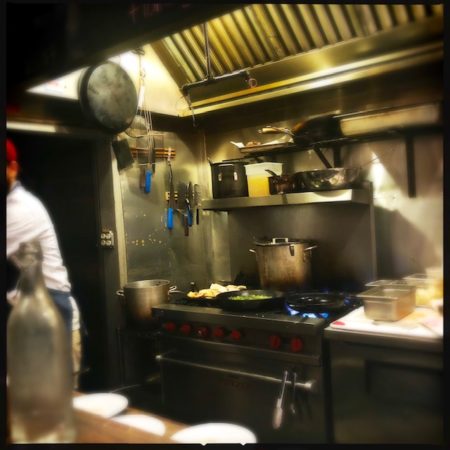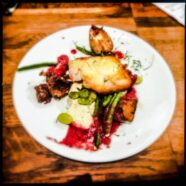Four years after opening, R Kitchen is still an innovative concept (Charleston City Paper)

When it opened in the summer of 2014, R Kitchen’s simple concept was also its flagship: Offer a limited number of nightly guests seating at a wooden bar flanking the minimal kitchen and open-shelved storage area. Positioned as fundamentally experiential, the website still boldly declares in all caps, “IT’S A KITCHEN, NOT A RESTAURANT.” While chef’s tables and open kitchens are nothing new, the novelty was in keeping it only a demonstration — limiting production to three seatings of roughly 12 guests each. In an August 2015 interview with Eater, chef-owner Ross Webb noted, “We say we’re going to serve 40 guests a night, and we stick to that.”
Flash-forward three-and-a-half years, and several things remain the same. Most notably the wooden bar, humble commercial kitchen, and unique five-course meal prepared every night. On the other hand, to willfully butcher the proverb, the more things stay the same, the more they change. Although on the surface R Kitchen bears a strong resemblance to its youthful self, the kitchen is all growed up; especially with respect to the scale. Now, there’s seating for “up to 16 guests in the kitchen or 20 on our covered patio.” The areas are separate, with the two chefs and a lone waitress hustling between them to service everyone. Likewise, just as the experience has physically doubled, it’s also exponentially less communal.
During my visit, there were eight of us lined up in a row in front and a full house in the back. Although sitting amongst them at the bar, I couldn’t tell you anything about my fellow diners, save a couple snippets I managed to overhear. The experience was almost exactly like, well, sitting at a bar. You might be close enough to touch the person next to you, but you don’t. In fact, the fundamental rules of elementary school — keep your hands to yourself, don’t bother your neighbor unless invited to do so, etc. — seemed to serve as a silent decree to which we all adhered. As for the people in the back? They could have been Klingons for all I know.
On the other side of the wood slab, the chefs have work to do and busily went about doing it. As they chop, slice, and sear, they’re accompanied by a wildly eclectic playlist. With selections ranging from Motown and R&B, to world fusion and dubstep, anticipate some mood-setting, mad mixtape skills.

As chefs Chris and Holmes began plating the first course, they launched into some introductory banter, with humorous proclamations that felt a touch like a well-worn stand-up routine. “If you’re a vegan, I can order you a taxi.” Ba-dum-tish. But hey, although there’s a revolving list of chefs, many of these folks have been performing this “dinner and a show” schtick twice a night for almost four years. Mild exhaustion from innovating a daily menu, not to mention pandering to the public, would be understandable.
In the spirit of updating food-based facts, the five-course prix fixe meal is now $35 a person. A choice of four wines are available for $8 a glass and $30 a bottle, with beers $5 each. There were also two wine upgrade options (a pinot noir and a sparkling rose) for $40 a bottle. (Word on the street is there’s a different, more wallet-friendly booze option at the West Ashley location.)
The dishes themselves ran the gamut from seasonal and inspired to mom’s leftover surprise. Our meal began with a sublime carrot ginger soup, founded on lemongrass and finished with a splash of ghost pepper chili oil. Then came a processed cheese-laden orzo tossed with chopped tomato and corn kernels. From Gary Danko to Denny’s in a single course. Still, when one considers that a bowl of such a soup as prepared by the venerable San Francisco eatery would cost about as much as the entirety of the five courses, you’re still way ahead of the game.
Moreover, in an era of growing food waste awareness, employing last night’s queso dip in today’s ‘tomato cheese pasta’ is commendable. In fact, some kind of scrap dinner featuring leftover carrot greens pesto, juice pulp veggie burgers, and more-or-less-rotten-banana cake with repurposed candied citrus peels might be right up their alley? I’d certainly be down to try it.

All the same, there’s really no point in discussing the (mostly) highs and lows of the dishes that came out of R Kitchen, as they’re unlikely to ever be made that way again. Innovation is the name of the game, and with that in mind, not only is R Kitchen’s transformation into something less personal and more profitable understandable, it’s admirable. Things change. Chefs evolve, businesses expand, time makes you bolder and even children get older, etc. R Kitchen has seemingly morphed what was most likely a ball buster of a business model into something less strenuous and more lucrative for everyone involved, while still keeping the core foundation of creativity intact.
On that note, I hope to take a page from them as I eyeball 2019. Whether you’re down with resolutions or anything auld lang syne, here’s to us all embracing change, doing more with less, and finding ways to work smarter, not harder. Dubstep optional.






